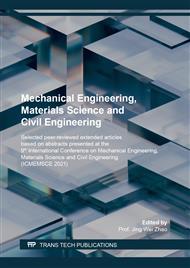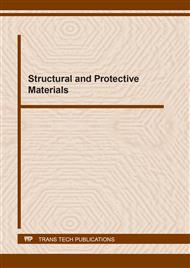[1]
I. Abu-Mahfouz, A. Banerjee, and E. Rahman, Evaluation of Clustering Techniques to Predict Surface Roughness during Turning of Stainless-Steel Using Vibration Signals,, Materials, vol. 14, (2021).
DOI: 10.3390/ma14175050
Google Scholar
[2]
H. Zhang, J. Liu, L. Chen, N. Chen, and X. Yang, Fuzzy Clustering Algorithm with Non-Neighborhood Spatial Information for Surface Roughness Measurement Based on the Reflected Aliasing Images,, Sensors, vol. 19, (2019).
DOI: 10.3390/s19153285
Google Scholar
[3]
J. M. Griffin, F. Diaz, E. Geerling, M. Clasing, V. Ponce, ChrisTaylor, et al., Control of deviations and prediction of surface roughness from micro machining of THz waveguides using acoustic emission signals,, Mechanical Systems and Signal Processing, vol. 85, pp.1020-1034, (2017).
DOI: 10.1016/j.ymssp.2016.09.016
Google Scholar
[4]
J. H. Oh and S. H. Lee, Prediction of surface roughness in magnetic abrasive finishing using acoustic emission and force sensor data fusion,, Proceedings of the Institution of Mechanical Engineers, Part B: Journal of Engineering Manufacture, vol. 225, (2011).
DOI: 10.1177/09544054jem2055
Google Scholar
[5]
C. Beggan, M. Woulfe, P. Young, and G. Byrne, Using Acoustic Emission to Predict Surface Quality,, International Journal of Advanced Manufacturing Technology, vol. 15, p.737–742, (1999).
DOI: 10.1007/s001700050126
Google Scholar
[6]
Z. Hweju and K. Abou-El-Hossein, Surface Roughness Prediction Based on Acoustic Emission Signals in High-Precision Diamond Turning of Rapidly Solidified Optical Aluminum Grade (RSA443),, Key Engineering Materials, vol. 841, pp.363-368, (2020).
DOI: 10.4028/www.scientific.net/kem.841.363
Google Scholar
[7]
J. Bhaskaran, M. Murugan, N. Balashanmugam, and M. Chellamalai, Monitoring of hard turning using acoustic emission signal,, Journal of Mechanical Science and Technology, vol. 26, p.609–615, (2012).
DOI: 10.1007/s12206-011-1036-1
Google Scholar
[8]
P. Garikapati, K. Balamurugan, T. P. Latchoumi, and R. Malkapuram, A Cluster-Profile Comparative Study on Machining AlSi7/63% of SiC Hybrid Composite Using Agglomerative Hierarchical Clustering and K-Means,, Silicon, vol. 13, p.961–972, (2021).
DOI: 10.1007/s12633-020-00447-9
Google Scholar
[9]
A. J. Torabi, M. J. Er, X. Li, B. S. Lim, and G. O. Peen, Application of Clustering Methods for Online Tool Condition Monitoring and Fault Diagnosis in High-Speed Milling Processes,, IEEE Systems Journal, vol. 10, pp.721-732, (2016).
DOI: 10.1109/jsyst.2015.2425793
Google Scholar
[10]
K. Choi and C. Jun, A systematic approach to the Kansei factors of tactile sense regarding the surface roughness,, Applied Ergonomics, vol. 38, pp.53-63, (2007).
DOI: 10.1016/j.apergo.2006.01.003
Google Scholar
[11]
R. Zhou, Y. Zhang, S. Feng, and N. Luktarhan, A Novel Hierarchical Clustering Algorithm Based on Density Peaks for Complex Datasets,, Complexity, vol. 2018, p.2032461, 2018/07/18 (2018).
DOI: 10.1155/2018/2032461
Google Scholar



